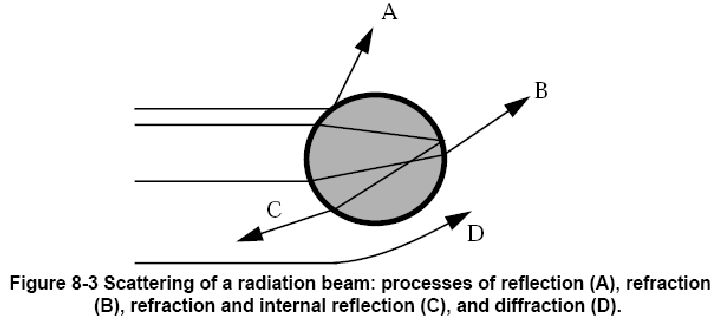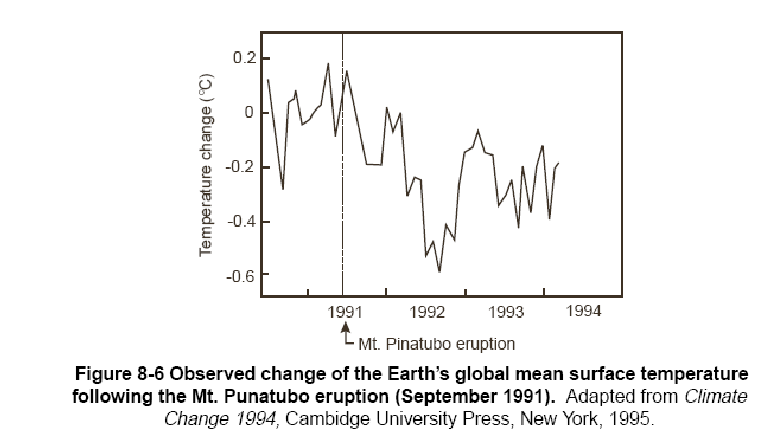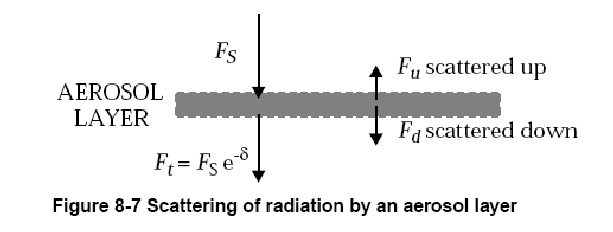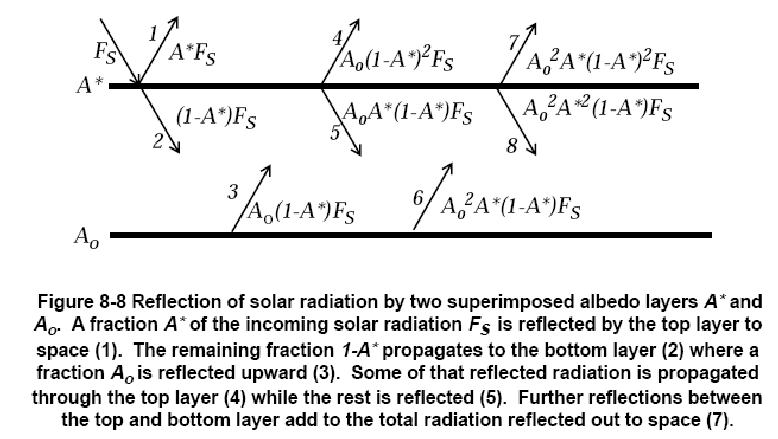
Radiative effects Scattering of radiation
A radiation beam is scattered by a particle in its path when its direction of propagation is altered without absorption taking place. Scattering may take place by reflection, refraction, or diffraction of the radiation beam (Figure ). We define the scattering efficiency of a particle as the probability that a photon incident on the particle will be scattered. Figure 4 shows the scattering efficiency of green light (= 0.5 m) by a spherical water particle as a function of particle size. Scattering is maximum for a particle radius corresponding to the wavelength of radiation. Larger particles also scatter radiation efficiently, while smaller particles are inefficient scatterers. Atmospheric aerosols in the accumulation mode are efficient scatterers of solar radiation because their size is of the same order as the wavelength of radiation; in contrast, gases are not efficient scatterers because they are too small. Some aerosol
particles, such as soot, also absorb radiation.


Visibility reduction
Atmospheric visibility is defined by the ability of our eyes to distinguish an object from the surrounding background. Scattering of solar radiation by aerosols is the main process limiting visibility in the troposphere (Figure 5). In the absence of aerosols our visual range would be approximately 300 km, limited by scattering by air molecules. Anthropogenic aerosols in urban environments typically reduce visibility by one order of magnitude relative to unpolluted conditions. Degradation of visibility by anthropogenic aerosols is also a serious problem in U.S. national parks such as the Grand Canyon and the Great Smoky Mountains. The visibility reduction is greatest at high relative humidities when the aerosols swell by uptake of water, increasing the cross-sectional area for scattering; this is the phenomenon known as haze (мгла).

Perturbation to climate
Scattering of solar radiation by aerosols increases the Earth’s albedo because a fraction of the scattered light is reflected back to space. The resulting cooling of the Earth’s surface is manifest following large volcanic eruptions, such as Mt. Pinatubo in 1991, which inject large amounts of aerosol into the stratosphere. The Pinatubo eruption was followed by a noticeable decrease in mean surface temperatures for the following 2 years (Figure 6) because of the long residence time of aerosols in the stratosphere. Remarkably, the optical depth of the stratospheric aerosol following a large volcanic eruption is comparable to the optical depth of the anthropogenic aerosol in the troposphere. The natural experiment offered by erupting volcanoes thus strongly implies that anthropogenic aerosols exert a significant cooling effect on the Earth’s climate.

We present here a simple model to estimate the climatic effect of a scattering aerosol layer of optical depth It is estimated that the global average scattering optical depth of aerosols is about 0.1 and that 25% of this optical depth is contributed by anthropogenic aerosols. The radiative forcing from the anthropogenic aerosol layer is:

where A is the associated increase in the Earth’s albedo (note that F is negative; the effect is one of cooling). We need to relate to A.

In Figure 7, we decompose the solar radiation flux incident on the aerosol layer (FS) into components transmitted through the layer (Ft = FSe-), scattered forward (Fd), and scattered backward (Fu). Because << 1, we can make the approximation e-1 - The scattered radiation flux Fd+Fu is given by
![]()
The albedo A* of the aerosol layer is defined as

As illustrated in Figure , an aerosol particle is more likely to scatter radiation in the forward direction (beams A, B, D) than in the backward direction (beam C). Observations and theory indicate that only a fraction 0.2 of the total radiation scattered by an aerosol particle is directed backward. By definition of

Replacing (8.4) into (8.3) we obtain
![]()
which yields A* x10-3 for the global albedo of the anthropogenic aerosol.

The actual albedo enhancement A is less than A* because of horizontal overlap of the aerosol layer with other reflective surfaces such as clouds or ice. Aerosols present above or under a white surface make no contribution to the Earth’s albedo. We take this effect into account in Figure 8-8 by superimposing the reflection of the incoming solar radiation FS by the anthropogenic aerosol layer (A*) and by natural contributors to the Earth’s albedo (Ao). We assume random spatial overlap between A* and Ao. The total albedo AT from the superimposed albedo layers A* and Ao is the sum of the fluxes of all radiation beams reflected upward to space, divided by the incoming downward radiation flux FS:

We sort the terms on the right-hand side by their order in A*. Since A* << 1, we neglect all terms higher than first-order:
![]()
so that the albedo enhancement from the aerosol layer is A = AT - Ao = A*(1 - Ao)2. Replacing into equation (8.1) we obtain the radiative forcing from the anthropogenic aerosol:

Substituting numerical values yields F = -0.9 W m-2, consistent with the values shown in Figure 7-15 and compensating about a third of the greenhouse radiative forcing over the past century. This direct forcing represents the radiative effect from scattering of solar radiation by aerosols. There is in addition an indirect effect shown in Figure 7-15 associated with the role of aerosols as nuclei for cloud droplet formation; a cloud forming in a polluted atmosphere distributes its liquid water over a larger number of aerosol particles than in a clean atmosphere, resulting in a larger cross-sectional area of cloud droplets and hence a larger cloud albedo. This indirect effect is considerably more uncertain than the direct effect but could make a comparable contribution to the aerosol radiative forcing.
Anthropogenic aerosols may explain at least in part why the Earth has not been getting as warm as one would have expected from increasing concentrations of greenhouse gases. A major difficulty in assessing the radiative effect of aerosols is that aerosol concentrations are highly variable from region to region, a consequence of the short lifetime. Long-term temperature records suggest that industrial regions of the eastern United States and Europe, where aerosol concentrations are high, may have warmed less over the past century than remote regions of the world, consistent with the aerosol albedo effect. Recent observations also indicate a large optical depth from soil dust aerosol emitted by arid regions, and there is evidence that this source is increasing as a result of desertification in the tropics. Because of their large size, dust particles not only scatter solar radiation but also absorb terrestrial radiation, with complicated implications for climate (problem 8. 2).
